
During the last year, the tempest of the troubled housing market and distressed financial sector has touched down in virtually every business sector and geographic region throughout the U.S. The economy of the St. Louis area, including the hotel industry, has not been wholly spared; however, it appears that the damage has not been too severe. Despite some setbacks, the St. Louis market has seen its share of relative success and has reason to anticipate growth once the skies clear.
Economic Snapshot
The St. Louis economy prospered during the upturn of the most recent economic cycle, but growth in the region was relatively modest compared to that of many major markets on the coasts and in the Sun Belt. Because its economy was not over-inflated, St. Louis has not suffered a marked decline. The city’s relative stability stems from its diversified employment base, including strong healthcare, education, government, research, energy, financial, and manufacturing sectors. Healthcare and educational institutions have continued to be a source of economic growth, as evidenced by the ongoing construction of the $235-million BJC Institute of Health at Washington University. Additionally, the steadfast presence of the U.S. government in the city, which includes operations of the Federal Reserve, the IRS, the Federal Judiciary, the EPA, and the Government Accountability Office, provides an underlying base of constancy.
Despite the ongoing crisis that has crippled many of the nation’s financial institutions, several firms based in the area, including Edward Jones, Stifel Nicolaus, and Scottrade, appear to be faring relatively well; in fact, both Edward Jones and Scottrade are currently expanding their operations. In the fall of 2008, Wells Fargo & Co. acquired Wachovia Corp., including St. Louis-based Wachovia Securities. Initial signs indicate that the merged investment operations, under the name Wells Fargo Advisors, will maintain its headquarters in St. Louis for the foreseeable future.
In the manufacturing and industrial sectors, the outlook is less rosy, but not altogether bleak. The ongoing struggles of the nation’s auto industry have negatively impacted the greater St. Louis area. Chrysler recently announced the planned closure of its Fenton, Missouri production plant, and the future of General Motors’ Wentzville assembly plant is uncertain as well. St. Louis-based Boeing Integrated Defense Systems, the area’s largest manufacturing employer, is expected to be negatively impacted by recently announced cuts to the national defense budget. The biggest corporate upheaval in the St. Louis area has been the sale of Anheuser-Busch to InBev in the fall of 2008. The Belgian-based company, which is notorious for its cost-cutting measures, has pledged to maintain St. Louis as its North American headquarters, but changes at the company have already had a negative impact on local advertising and law firms, as well as other companies that provided support services to Anheuser-Busch.
Hotels
The biggest news in the St. Louis hotel market has been the ongoing saga of the Renaissance Grand Hotel & Suites, St. Louis’ flagship convention hotel and the largest lodging facility in the metro area. The hotel has continually failed to generate enough revenue to cover debt service payments, and bond holders took control of the property in January of 2009. On the surface, the failure of this hotel would seem to indicate a severe downturn in the St. Louis hotel market. In reality, this was a somewhat isolated case that has been a long time in coming.
The recession may have put the nail in the coffin, but the hotel has been plagued by unforeseen obstacles and unrealistic expectations since before it opened. The construction of the hotel was delayed and over budget; as a result, the property opened in 2003 during a recessionary market with a high debt load. The original revenue projections that were used to justify construction costs were based on excessively optimistic projections of future convention activity that never materialized. Original studies projected convention-center-generated room nights to nearly double in four years, from 500,000 in 2000 to 800,000 by 2004.1 Since 2003, the year the Renaissance opened, annual room nights have increased at a pace much slower than those expectations, topping 550,000 in 2008 (see table below).
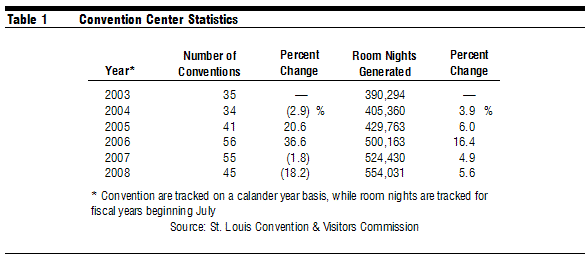
The inability to draw projected convention attendance and meet forecasted occupancy levels at the Renaissance was directly tied to unforeseen changes at Lambert-St. Louis International Airport. In 2003, American Airlines drastically reduced its presence at the airport. As a result, St. Louis lost non-stop service to numerous domestic and foreign destinations; passenger traffic levels plummeted and have not yet recovered (see table below).
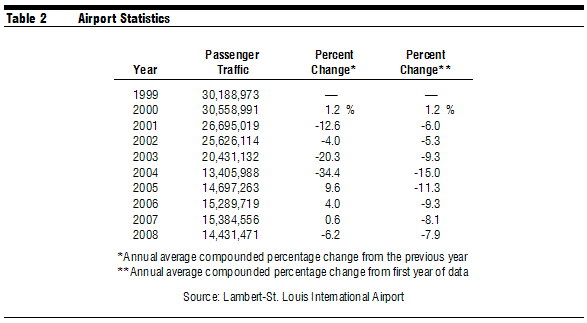
The loss of airline passengers and lackluster convention attendance impacted nearly every hotel in the region, yet most properties were able to adjust. In contrast, the excessive debt load of the Renaissance proved insurmountable, as the hotel never became a profitable operation and quickly slipped into default when the market took a downturn in 2008. Despite its ill fate, the Renaissance is an elegantly designed, well-run property. The current situation should provide an opportunity for a new owner to step in with a more manageable debt load and turn the hotel into a profitable operation.
Overall, the St. Louis hotel market has been negatively impacted by the ongoing economic downturn, but not devastated. Information from the 2008 HVS Hotel Valuation Index, a measure of relative hotel values for the top 65 markets in the U.S., indicates that St. Louis has historically been the most stable market since 1997(see table below).2
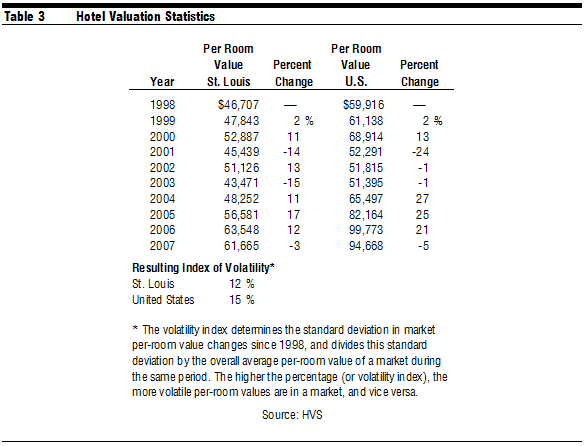
Additionally, in comparison to the other top 25 markets in the country, St. Louis appears to be performing relatively well in 2009, as evidenced by the Smith Travel Research Weekly Hotel Reports for the month of March (see table below).
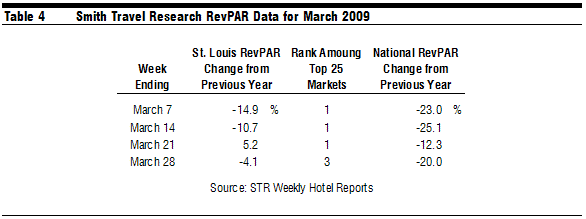
Of course, since national RevPAR is expected decline approximately 12% in 2009, "relatively strong" performance is not in itself a reason to celebrate.3 Hotels that may have difficulty surviving the downturn include: aging properties that require renovations, recently opened properties with high debt loads, and under-performing properties with pending mortgage maturities. St. Louis hoteliers should nonetheless maintain hope that performance declines will be manageable, particularly at well-established, well-run properties.
The Demand Story
A number of broad trends and specific circumstances provide further indication of relatively mild declines for the St. Louis market in 2009 and hint at what recovery might look like in the years to come. In 2008, markets across the country, St. Louis included, suffered from significant occupancy declines. In the spring of 2008, the St. Louis market began to experience declines within the transient commercial segment, as area corporations trimmed travel budgets and curtailed travel needs. High gas prices in the summer of 2008 added additional downward pressure on demand levels, as reduced leisure travel to and through the area resulted in a lackluster summer travel season. In the fall, as seasonal leisure travel slowed and corporate transient demand remained depressed, the bottom fell out of the national economy leading to further deterioration. Nationally, negative publicity over extravagant corporate junkets caused cancellations of meetings and conferences across the country; the resulting demand declines were most pronounced in the luxury segment and at resort-style properties. While St. Louis has relatively limited exposure to these segments, it was impacted, although not as severely as many other markets.
This was confirmed by Kathleen "Kitty" Ratcliffe, Director of the St. Louis Convention and Visitors Commission, in a recent interview published in the St. Louis Business Journal.4 She indicated that while the convention center has experienced a number of cancellations, the impact has not been severe. As a relatively modest and low-cost destination, events held in the region do not have the appearance of opulence that has been vilified in the media. Additionally, several major events that took place in early 2009, including the NCAA Wrestling Tournament and the NCAA Women’s Final Four, have helped limit demand declines in the group segment.
According to several local hotel operators, demand levels appear to be stabilizing in the spring of 2009. Transient demand from non-leisure sources continues to be depressed, but has not fallen significantly since 2008. However, this segment has become much more rate-sensitive as travel planners shop around for the best deals. Within the group segment, cancellations have reportedly been relatively isolated. Corporate meeting planners have been willing to accept upgraded or discounted food and beverage packages, rather than being overly aggressive in negotiating room rates. Demand from the leisure segment is reportedly picking up, resulting in a cautiously optimistic outlook for the summer season. With gas prices remaining well below 2008 levels, local attractions and special events, such the Major League Baseball All-Star Game, should draw significant levels of regional tourism this summer.
The Supply Factor
The ongoing recession in the national hotel industry has been largely driven by reduced demand rather than increased supply. As such, many industry insiders anticipate that national hotel performance should improve rather quickly when the economy recovers and demand levels rebound. St. Louis has run counter to this trend, with less dramatic demand decreases but a relatively significant expansion of the local rooms supply during the last several years.
Since 2005, 32 hotels have opened in the St. Louis market and nine more are currently under construction and slated to open in 2009. This growth represents 5,053 net new rooms and a 14.8% supply increase from 2005 through 2009. As illustrated by the chart below, supply in the St. Louis market has grown somewhat faster than the national average, indicating that a slower, more drawn out recovery may be in store for the greater St. Louis area. With that being said, the timing and speed of recovery will vary from submarket to submarket in the region, depending on the strength of proximate demand generators and the level of local supply growth.
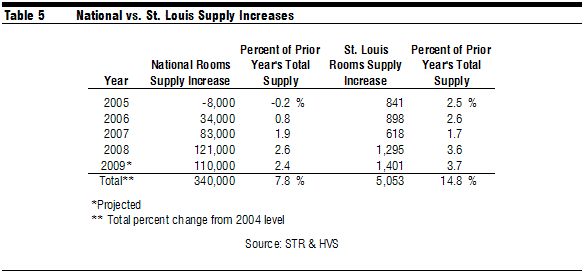
Conclusion
Overall, the St. Louis economy and hotel market have been negatively impacted by the ongoing economic turmoil, but few hotels are boarding up their windows. Some of the city’s economic sectors are stable or strengthening; others face uncertain futures. Depressed demand levels are anticipated for the remainder of 2009; however, it appears that recent declines are stabilizing. The extent of recent supply growth in the region is expected to result in an extended period of absorption and recovery as demand levels rebound. As such, the St. Louis area hotel market should continue to perform much as it has done in the past, with less dramatic cyclical peaks and valleys than are seen in many other markets across the country.
1 2004, August 31. Moody's cuts bond ratings on Renaissance hotels. The St. Louis Business Journal.
Jackson, Margaret.(2004, April 9). (Un)Conventional St. Louis. The St. Louis Business Journal.
2 The Hotel Valuation Index (HVI) tracks hotel values in 65 major markets and the United States as a whole. Created in 1987 by HVS, the HVI is derived from an income capitalization approach, utilizing market area data provided by Smith Travel Research (STR) and historical operational information from HVS’ extensive global experience in hotel feasibility studies and valuations. Based on HVS’ experience of real-life hotel financing structures appropriate valuation parameters are applied for each market, including loan-to-value ratios, real interest rates, and equity return expectations.
3 HVS. U.S. Hotel Trends – Yesterday, Today, and Tomorrow.
4 Ave, Melanie.(2009, April 3). Convention cancellations become more common in St. Louis. The St. Louis Business Journal.

0 Comments
Success
It will be displayed once approved by an administrator.
Thank you.
Error